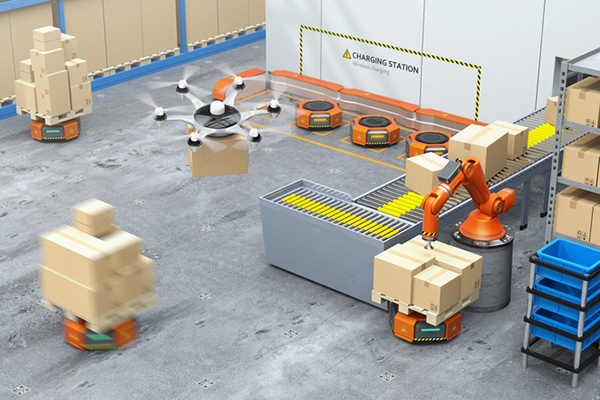JLL takes a deep dive into key components of future warehousing
The report, entitled “Warehouse of the Future: 9 attributes that are redefining industrial properties today,” observes how as industrial vacancies continue to fall alongside rising operating costs and shrinking availabilities of prime land parcels
The increase in sophisticated technologies and attributes needed to help meet growing e-commerce demand and warehouse throughput continues to rise, with no signs of slowing down, according to a research report issued this week by Chicago-based commercial real estate firm JLL.
The report, entitled “Warehouse of the Future: 9 attributes that are redefining industrial properties today,” observes how as industrial vacancies continue to fall alongside rising operating costs and shrinking availabilities of prime land parcels, the continued growth of e-commerce, last-mile delivery, and warehousing are collectively driving significant demand for industrial properties, as well as driving innovation in terms of how assets are built and utilized.
What’s more, the firm pointed out that given tight logistics vacancy rates currently below 3%, a tight labor market that is necessitating more warehouse technologies, and a dearth of needed prime developable land, and increasing demand for last-mile distribution facilities, JLL said this has led to more heightened attention for small- and mid-sized buildings, with around 60% of new warehouse development made up of facilities ranging from 50,000-to-250,000 square-feet.
The nine attributes redefining industrial properties, as per JLL’s research, include: wireless technology and real-time tracking; a hyper-connected facility; the new forklift; growing clear heights; picking tech, picking up speed-related technologies such as automated robots or shuttles and new picking technologies; sustainability making strides in buildings through things like solar panels, LED lighting, and cool roof systems, among other things; human-centric design placing a growing importance on workers’ quality of life through the implementation of things like proper lighting, air quality sensors, and temperature control, among others; land flexibility for things like additional truck storage or physical building expansions; and super flat to sloped flooring to achieve greater efficiencies.
“What we are seeing in terms of how these warehouse are being set up and designed compared to five or ten years ago, when standard warehouses were all racking-based, with a picker getting on a forklift and driving around a facility to pick up goods to bring to a dock and then get shipped, is that now most facilities we are building are packed with technology and automation, where the goods sort of come to the employee,” said Rich Steger, JLL managing director and national Industrial Project Management lead, in an interview. “Now, the employee is near the dock, and the goods come to the employee. They pick the goods out as part of a carton, and the carton goes back by itself and restores itself. It is a 180-degree shift in how the inside of the box works.”
The JLL executive explained that this pattern is driven by what is likely a permanent shift from brick and mortar retailers to online shopping.
This pattern, he said, is leading retailers to essentially invert and reconfigure their entire supply chain, including distribution networks, to being heavily e-commerce-driven.
“A lot of retailers today are building with the future in mind, with the majority of their goods being ordered online and being shipped,” he said. “It is not pallets or cartons to stores anymore. Many times instead, it is single items going to the consumer. Now, you can go online an order a single $10 item and not be charged for shipping with next-day delivery. That is a big shift.”
When asked what the biggest influence within the myriad attributes impacting warehousing operations now and into the future, Steger did not hesitate to cite automation.
The reason for that, he said, is that by necessity warehouse and distribution center operators have shifted to automation, due to the way in which goods are ordered, driven in large part by the labor shortage, which has led to a need to spend on equipment to serve their customers.
“When you look at automation, it is really all the technologies you see like wireless and robotics,” he said. “We are now routinely looking at automated systems, which are pretty complicated and pretty imposing on a building. Around five years ago, we started seeing buildings that were serving e-commerce companies being build as customized, or build-to-suit, facilities. You can only build those so fast, and this trend is so overwhelming that technologies have been developed that are putting these automation systems inside spec [speculative] buildings in which even though the building is built already, we are still putting these highly automated systems in, so there is a lot of conversion required for a spec building, rather than just for general usage. We are spending a lot of time customizing standardized buildings to accommodate some of these systems.”
Today’s warehouse operators, according to Steger, are more comfortable with automated systems, noting that even five years ago there was resistance by them to spend a lot of money doing that type of change management and retraining employees, whereas now there is more acceptance, along with the ongoing technological advancements that have been made.
“What we are going to see is that all of distribution is going to look and feel this way, because those that don’t get there are not going to be around,” he said. “Everyone is trying to keep up with the big players or even copy them, and we some succeeding in doing so. There are a lot of companies working hard now to make this right for their future growth.”













